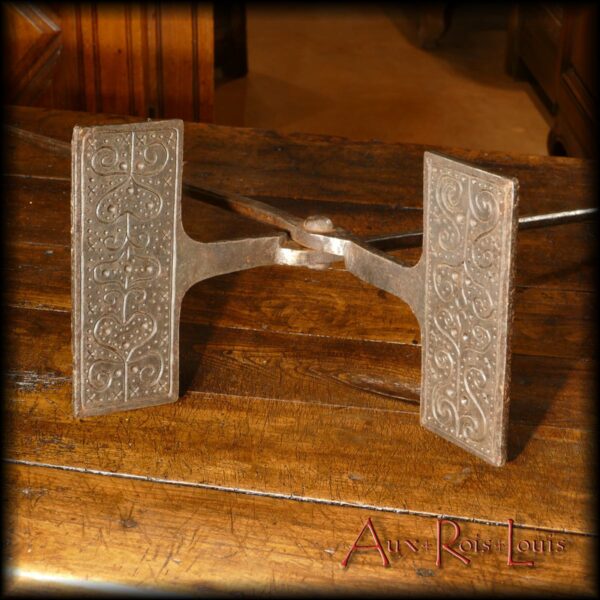Royal Cast Iron Fireplace Plate – 17th Century – Périgord – [ME113]
Impressively sized, this fireplace plate from the illustrious foundries of Périgord displays traditional royal heraldry – a crown surrounded by fleur-de-lis and pine cones, symbolizing longevity. Cast in 1644, the historical significance and authenticity are highlighted by this embedded date.

![Royal Cast Iron Fireplace Plate – 17th Century – Périgord – [ME113] Impressively sized, this fireplace plate from the renowned foundries of Périgord showcases traditional royal heraldry, featuring a crown surrounded by fleur-de-lis and pine cones, symbolizing longevity. Cast in 1644, the inclusion of this date in its design adds to its historical appeal and authenticity.](https://www.aux-rois-louis.com/wp-content/uploads/2023/09/ME113_plaque_de_cheminee-600x600.webp)
![Fireplace Bench in Oak and Chestnut – 19th century – Auvergne – [MP049] This bench, made with oak and chestnut planks, was originally placed inside an Auvergne "cantou." This large fireplace, which welcomed it due to its depth, gave it a crucial role: to welcome the brave, cold-stricken peasants to warm up and to chat or dance during the evenings around the fire. In short, this famous "cantou" was the stage for the only moments of respite and comfort in courageous lives of labor, throughout the seasons.](https://www.aux-rois-louis.com/wp-content/uploads/2023/09/MP049_660-600x600.webp)
![ME079_P1660184det Cast iron fireback – Louis XV – 18ᵗʰ century – South-West – [ME079]](https://www.aux-rois-louis.com/wp-content/uploads/2022/04/ME079_P1660184det-600x600.jpg)

![Studded Travel Trunk – 18th Century – China – [ME126] This studded travel trunk originates from the mountainous region of Hubei, also known as the Province of a Thousand Lakes, situated in central China. The ochre and green hues that surface are original. Upon closer inspection of the facade, vertical inscriptions in Chinese characters can be discerned. The rings are loops for the ropes that allowed this travel trunk to be carried through the rugged mountains of Hubei, either by man or mule. The studded iron fittings reinforcing its corners enabled it to withstand shocks and reach us in a beautiful state of preservation.](https://www.aux-rois-louis.com/wp-content/uploads/2024/02/ME126_P1680293-600x600.webp)

![Larch wood table for cracking walnuts (énoisage) – 19th century – Haute-Loire – [MP051]] This authentic "paysan" rural piece of furniture, from around the foothills of Velay, is a testimony of the spirit of friendly mutual assistance among neighbours who went to one another's homes to do the "énoisage" all together during the late evening "velhada", sometimes improvising friendly little dances to the sound of clogs, "cabrettes" and accordions.](https://www.aux-rois-louis.com/wp-content/uploads/2023/10/MP051_P1670111-600x600.webp)
![Cherry Wood Salon Table – Louis XIV – 18th Century – South West – [ME112] Here is a small cherry wood salon table commissioned by a castle in Périgord in the 18th century. It follows the codes of the Louis XIV style, featuring a moulded balustrade base connected by an H-shaped stretcher and blackened mouldings on the side rails. It has a drawer that spans its entire width.](https://www.aux-rois-louis.com/wp-content/uploads/2023/09/ME112_654-600x600.webp)
![Glazed Terracotta Oil Barrel – 19th Century – Saintonge – [PA080] This oil barrel comes from the renowned pottery center of La Chapelle-des-Pots, located in the former province of Charentes, known as Saintonge. Exclusively in Saintonge, from the Middle Ages onward, these barrel-shaped potteries were crafted using the beautiful local clay, reserving walnut oil for the lighting of each household.](https://www.aux-rois-louis.com/wp-content/uploads/2023/11/PA080_P1670098-600x600.webp)
![Peasant Water Jug in Glazed Terracotta – 19th Century – Auvergne – [PA078] This glazed terracotta water jug comes from a countryside workshop in Brioude, Haute-Loire, France. This type of Auvergnat pottery workshop operated only in winter when farmers were free from fieldwork. The clay is red due to its natural iron oxide content. This raw clay was grogged, meaning it was mixed with river sand and crushed fired clay.](https://www.aux-rois-louis.com/wp-content/uploads/2023/12/PA078_P1670085-600x600.webp)
![Bell Bronze Pie Dish – 19th Century – Southwest – [MP043] Here is a pie dish that has the particularity of being cast right after a church bell, in order not to waste any of the molten metal. Therefore, it is made of the same bronze and can be considered the little sister of a bell, just a few minutes apart, though not an exact twin.](https://www.aux-rois-louis.com/wp-content/uploads/2023/06/MP043_570-600x600.webp)
![Two inseparable walnut armed chairs – Louis XIII – Quercy – [ME089] Examples of seats considered comfortable under Louis XIII, here are two armed chairs with almost straight backrests whose softness lies rather in the way of the armrests, finished in a butt, and the turning, in the Renaissance spirit, of the uprights connecting backrests and armrests at the base.](https://www.aux-rois-louis.com/wp-content/uploads/2022/12/ME089_448C-600x600.webp)
![Desk table in oak and chestnut – Louis XIII – 17th century – Quercy – [ME074] This desk table was probably the prerogative of a high dignitary of the Customs corps, in charge of a flourishing trading post located on the banks of the Olt, the former name of the Lot.](https://www.aux-rois-louis.com/wp-content/uploads/2022/06/ME074_116-600x600.jpg)

![Large cast iron vat for laundry Large cast iron vat for laundry – 16ᵗʰ century – Fonderies du Périgord – [ME076]](https://www.aux-rois-louis.com/wp-content/uploads/2022/05/ME076_P1660128-600x600.jpg)
![Salt chest armchair – chestnut - cherry - poplar – 19th century – Quercy – [MP029]](https://www.aux-rois-louis.com/wp-content/uploads/2022/03/MP029_733-600x600.jpg)
![Terracotta ham pot – 19th century – Charente – [PA067]](https://www.aux-rois-louis.com/wp-content/uploads/2022/02/PA067_715-600x600.jpg)

![Cherry wood farm table – 19th century – Périgord – [MP024]](https://www.aux-rois-louis.com/wp-content/uploads/2021/11/MP024_125x900-600x600.jpg)
![Cast iron andirons - 18th century - Périgord - [ME062]](https://www.aux-rois-louis.com/wp-content/uploads/2021/09/ME062_013-600x600.jpg)
![Cast iron andirons - 18th century - Périgord - [ME062]](https://www.aux-rois-louis.com/wp-content/uploads/2021/09/ME062_P1610011-600x600.jpg)